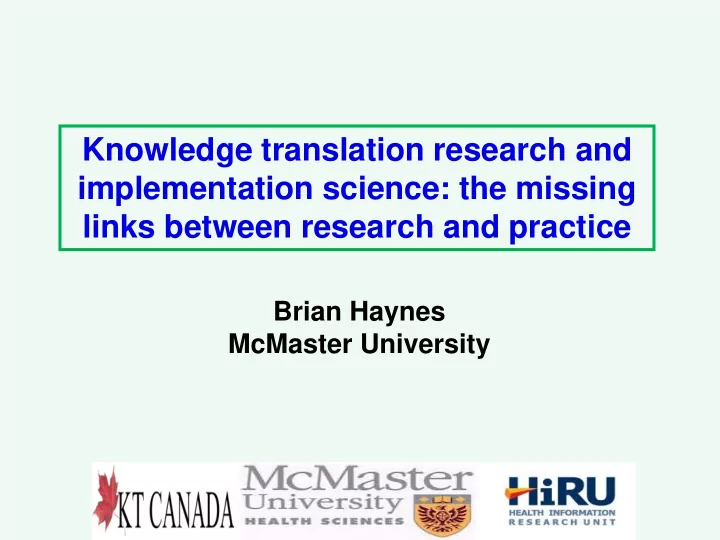

Knowledge translation research and implementation science: the missing links between research and practice Brian Haynes McMaster University
Conflict Disclosures None for this presentation Speaker: R Brian Haynes: Closing the loop on scientific discovery. 19/10/2013
How successful is EBM? (as a % of potential) How successful % of audience • <25% is EBM now? • 25-49% <25% 25-49% • 50-74% 50-74% • 75-100% 75-100%
Attributed by Richard Smith to The Idealist
Premises • A barrier, the ‘knowledge -practice gap ’, largely blocks the application of health research in clinical and population settings. • Overcoming ‘gap’ problems would save many lives. • Knowledge translation research (KTR) is a youthful enterprise, trying to understand ‘gap’ problems and find ways to overcome them.
By the year 2020, 90% of clinical decisions will be supported by accurate, timely, and up-to-date clinical information and will reflect the best available evidence. IOM Roundtable on Evidence-Based Medicine This can’t happen without better understanding of how to translate knowledge into practice.
Knowledge Translation Research KT Type 1 KT Type 2 Implementation Science Clinical Health † Lab * Comparative effectiveness research; research care Patient centred outcomes research; Dissemination and Implementation * Zerhouni. JAMA. 2005;294:1352-1358 † Hulley et al. Designing Clinical Research, 2007
E X KT2 = ROI Knowledge Return on Efficacy Real Translation Investment Outcomes of (type 2) Importance
E X KT2 = ROI Clinician Where: adherence E is typically ≤ 0.25 ~ 50% KT2 is typically ≤ 0.25 Patient So: adherence ~50% ROI is typically... .25 X .25 = .06
E X KT2 = ROI Clinician Where: adherence E is typically ≤ 0.25 50% KT2 is typically ≤ 0.25 So: Patient adherence ROI is typically... 50% 75% .25 X .25 = .06 .09 .38
E X KT2 = ROI Where: Clinician Clinician E is typically ≤ 0.25 adherence adherence 50% 75% 50% 75% KT2 is typically ≤ 0.25 Patient So: adherence 50% 75% ROI is typically... .25 X .25 = .06 .14 .56
For atrial fibrillation: E Efficacy of warfarin for preventing stroke = 62% KT2 Physician adherence = 50% Patient adherence = 41% ROI = 12%
5 generation synthesis policy application decisions 4 3 2 1 Knowledge Translation Research funding Steps from evidence generation to clinical application 1. generation of evidence from research; 2. evidence summary and synthesis; 3. forming clinical policy; 4. application of policy; 5. individual clinical decisions, including a) patient’s circumstances, b) patient’s wishes, and c) evidence
Step 1. Generating Research Evidence Barrier Solutions • too little • large, simple RCTs with research patient-important outcomes addresses “real • “head to head” comparisons world” problems
“Can this “Does this work?” trials work?” trials “Is it worth it?” trials
Look AHEAD Research Group, Wing RR, Bolin P, et al. Cardiovascular effects of intensive lifestyle intervention in type 2 diabetes. N Engl J Med. 2013;369:145-54. Conclusion In patients with type 2 diabetes mellitus who were overweight or obese, an intensive lifestyle intervention for weight loss did not reduce major cardiovascular events compared with diabetes support and education.
a c b drugs Knowledge Translation Steps from evidence generation to clinical application Steps: 1. generation of evidence from research; 2. evidence summary and synthesis; 3. forming clinical policy; 4. application of policy; 5. individual clinical decisions, including a) patient’s circumstances, b) patient’s wishes, and c) evidence from research
a c b devices & services Knowledge Translation Steps from evidence generation to clinical application Steps: 1. generation of evidence from research; 2. evidence summary and synthesis; 3. forming clinical policy; 4. application of policy; 5. individual clinical decisions, including a) patient’s circumstances, b) patient’s wishes, and c) evidence from research
5 decisions Step 5. Influencing individual patient decisions, actions and outcomes Barrier Solutions • failure to engage • encouraging patients adherence to recommended treatments
Detection Doctors’ judgements of their patients’ adherence: • sensitivity 10% • specificity 88% no better than chance accuracy Gilbert et al, CMAJ 1980
How frequent is nonadherence? TASK NON- ADHERENCE RATES* Screening in community 35%-90% Referral from screening 50%-65% Staying in care 31%-66% Follow-up appointments 16%-84% Medications 31%-58% Weight loss 29%-100% Smoking cessation 71%-96%
ASA statin ACEi metformin UMPIRE Trial (Thom et al. JAMA. 2013;310:918) Adherence: polypill 86% vs individual pills 65% – 2.6 (95%CI -4 to -1.10) Delta SBP: – .11 mmol/L (-4.2 mg/dL) Delta LDL-C: Limitations • Polypill provided free • Adherence measured by self report, in an polyp po ypill ill unblinded trial • No patient important outcomes
Heart bar…
Cardiovascular Health Awareness Project Kaczorowski et al, BMJ 2011 Intervention Communities were randomised to receive CIHR Trial of the Year 2012 CHAP (n=20) or no intervention (n=19). In CHAP communities, residents aged 65 or over were invited to attend volunteer run cardiovascular risk assessment and education sessions held in community based pharmacies over a 10 week period ; automated blood pressure readings and self reported risk factor data were collected and shared with participants and their family physicians and pharmacists. Reduced admission rates for a composite of MI, CHF, stroke
5 generation synthesis policy application decisions 4 3 2 1 Knowledge Translation Research funding Steps from evidence generation to clinical application 1. generation of evidence from research; 2. evidence summary and synthesis; 3. forming clinical policy; 4. application of policy; 5. individual clinical decisions, including a) patient’s circumstances, b) patient’s wishes, and c) evidence
Key resources if you are interested in Knowledge Translation research: http://plus.mcmaster.ca/kt/
By the year 2020, 90% of clinical decisions Could this be the final frontier in will be supported by accurate, timely, and evidence-informed health care? up-to-date clinical information and will reflect the best available evidence. This can happen if our IOM Roundtable on understanding of knowledge How could you help? Evidence-Based Medicine translation improves – and we discover how to apply what we learn.
Recommend
More recommend